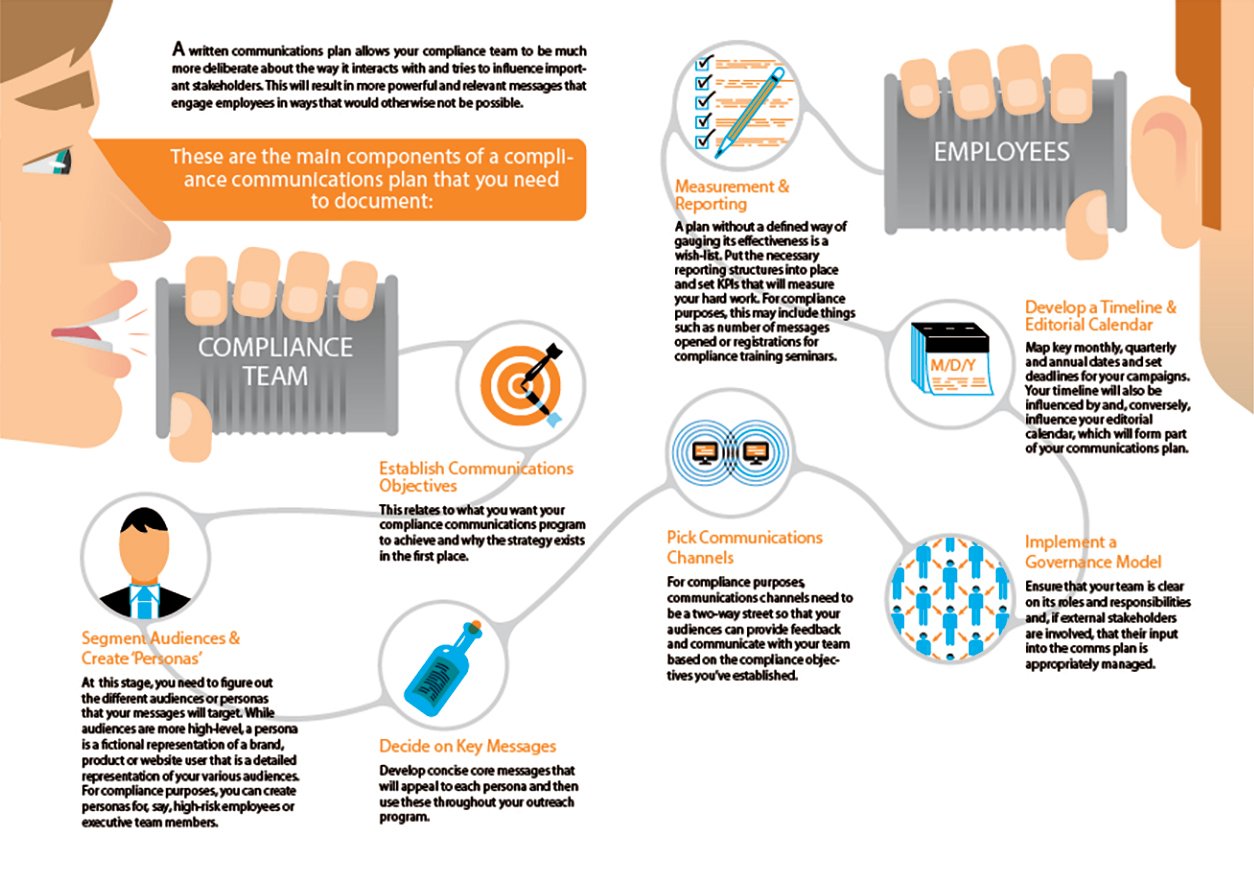Insight Blog
Agility’s perspectives on transforming the employee's experience throughout remote transformation using connected enterprise tools.
9 minutes reading time
(1737 words)
Create Your Compliance communication plan template
A Communications Plan is a document that describes how you are going to communicate the right messages, to the right people, at the right time.
Compliance communication plans provide businesses with an efficient way to ensure that legal information or updates related to compliance are communicated across their organization.
A Compliance communication plan template serves as a blueprint, providing a detailed framework of best practices for any company looking to create such plan.
The template includes components like target audience identification, message design, stakeholder mapping, and more. Additionally, sample content such as email templates and promotional materials can also be included in order to supplement the template and provide companies with additional guidance to help create their own successful Compliance communication plan.
It's an invaluable tool for companies looking to comply with the government regulations that they are legally obligated to follow.
It doesn't matter if your product is the best in the world; if no one knows about it, it won't sell. It's important to put money into effective advertising methods to get the word out. The same holds for a business's compliance program.
There is a mountain of rules and regulations, and more keep getting introduced or tweaked. What alternatives do you have for communicating with your staff and keeping them up to date?
The sheer volume of company regulations makes it reasonably challenging for workers to navigate. Similarly, not all of them may have the intrinsic incentive to keep themselves up to speed on such matters, or they may just lack time to do so.
Departments that issue regulations do not want them buried in a sea of emails or forgotten in the corner of the intranet. In this article, you will find tips for avoiding that scenario and a template for a compliance communication plan.
How can an organization create a compliance communication plan?
It is important to avoid ineffective communication when it comes to compliance. Communication breakdowns can lead to hurt feelings, broken bonds, distrust, and even violence. A misaligned plan, a failure to execute the strategy, incorrect communication channels, poor timing, and even subtleties like word choice or tone of voice can all contribute to ineffective communication.
Here is what you can do:
Identify your target audience
The tone and pace at which you deliver your message must change according to who you're speaking to. Keep in mind that your compliance message will touch a wider group of people than just the primary audience.
Before sending a message to the whole company, think about who exactly you'll reach out to. Their location and level of expertise are other important considerations. Determine the most effective means of conveying your message to the target audience.
Establish a single source of information
Legal and compliance professionals aren't the only ones with access to an organization's policy and regulatory documents. This includes departments like Information Technology/Data Security, Finance, and Human Resources.
Providing a central point of contact for inquiries about regulations across all divisions and fields of expertise can greatly facilitate the discovery of pertinent data. Important policy information from different departments is spread out across the intranet and employee emails, making it difficult for employees to find what they need when they need it.
Employees may now quickly and easily get the information they need without sifting through numerous internal emails or web pages.
Publish appropriate content
It's important to give some thought to the exact wording of your directions. It's easy to forget that most employees could have trouble following the text of the original directives and regulations because compliance officers spend their days steeped in the language of legislation.
Condense the crucial information people need to know and present it in simple, straightforward language. Focus on the sections that directly apply to each division in your communications. Ensure that they have a complete understanding of their roles.
Establish communication channels
Overburdening employees with information is a potential risk to compliance communication. In such a scenario, employees may miss vital details, leaving the company vulnerable to compliance problems.
Consider how your company communicates internally before deciding on a compliance communications strategy. Compliance information could be included in monthly emails sent out by other departments; for example, human resources. Instead of sending two separate emails, merging the two into one reduces the risk of overloading recipients' inboxes.
Internal communications events, such as all-hands or town hall meetings, are another means to distribute compliance knowledge. Instead of calling a special meeting and pulling workers away from their duties, you can present crucial, readily assimilated information at a routine event.
Use internal communication channels like intranet
Businesses can use specialized groups to keep their staff informed of key regulatory changes via internal communication channels like the intranet. Alternatively, digital solutions like a compliance app can be utilized to make it simple to display updates on the platform through notification icons similar to messaging apps.
A company's internal publications, such as a blog or magazine, can also report compliance-related themes and challenges. The purpose of many firms' periodic internal newsletters is to keep staff abreast of company news and developments.
Use internal monitoring systems
The good news is that numerous reporting and monitoring solutions exist to handle compliance management. As a result of the automation these platforms provide, your compliance operations will become more efficient, freeing up valuable time for your staff while ensuring that your business remains in full compliance with all applicable regulations.
Keep employees interested
There needs to be a systematic and constant effort to raise awareness among employees about the need for compliance, not just when there are changes to policies and regulations. The intranet provides a perfect platform, as employees may be reminded to review company policies and get any missing knowledge. A quick quiz on the company intranet, where employees are asked a topic and encouraged to take a guess before being linked to more content on the specific policy, is another option.
Conduct regular reviews
Keep tabs on and test your message to see if it is interesting and effective. Take the pulse of your staff to find out how well they understand their regulatory responsibilities and how they feel about the way you've been conveying those responsibilities to them.
It's important to check in on your communication methods and messages regularly. Conduct an audit of your compliance efforts to identify any bottlenecks in the processes and determine whether they result from a lack of communication between the compliance department and employees.
Use microlearning methods
Using microlearning strategies is another effective method of training staff on compliance topics. Employees could be sent brief messages via a compliance platform to access relevant regulatory information whenever and wherever it is most convenient. Staff members can keep their education going and benefit from increased retention.
Microlearning methods can be used alone or as a supplement to traditional classroom or online instruction. E-learning methods alone have their limits; using the full potential of microlearning technologies will significantly increase their efficacy.
Provide training to trainers
Forgetting the value of team meetings is a common blunder made by businesses when it comes to communicating about compliance. Rather than a one-day training program once a year, which staff may not remember until the next training, keeping compliance on the agenda for monthly team meetings may be more effective.
This ensures that staff are regularly reminded of the requirements and provides a forum in which compliance-related issues can be discussed in depth. Then, managers and team leaders can be educated on how to use compliance-related language to inspire their teams effectively.
Get feedback from employees
Encourage employees to provide input on both the compliance program and related messaging. By conducting a poll, you may get valuable feedback from your staff without compromising their anonymity.
By conducting a survey, you may learn where and how your employees would like to hear about the program.
Important things to consider in the compliance communication plan
When it comes to communication related to compliance initiatives, there are several important factors to consider. First and foremost is a consistent tone of voice - this should be professional yet approachable, demonstrating that the speaker or writer is knowledgeable about the topic at hand. It is also important to ensure that messages are kept simple and clear, making sure that employees understand the importance of compliance with respect to their roles in the organization.
Role of leadership
Building a strong business culture, encouraging openness and transparency, and having well-informed, engaged staff all require effective leadership communication. In order to inspire trust and confidence in your leadership, your messages should be genuine and emphasize the openness of your organization's top brass to their staff.
A common mistake made by leaders is sending signals that aren't sincere and come across as arrogant or condescending. Sometimes the meaning is lost because of excessive jargon and complex terminology. Simple and plain language may help you keep on track, and that's exactly what you'll get with a leadership internal communication plan.
Communication in the IT department
IT-related announcements to the rest of the company are a regular and predictable aspect of internal communications. This category falls into power outages, software updates, and scheduled maintenance. Due to the frequent nature of these communications, it is prudent to have pre-made templates at your disposal.
Responding to emergencies
Emergencies typically occur without any prior warning. In a dire situation, every second counts and may determine a person's fate. The more quickly you can compose an internal communication, the more time your staff will have to take precautions.
Employee recognition
Showing your staff some love, especially after they've accomplished something noteworthy, is a great way to increase morale. Employees who go above and beyond to aid their coworkers are examples of those who achieve exceptional accomplishments.
You can download the compliance communication plan template from here:
Wrapping up
Suppose you want your compliance communication plan to be effective. In that case, you need to consider the reality that various audiences have varied information needs and will respond best to different channels. The people who will be tasked with carrying out your communication plan's regulatory duties need clear, concise information that they can put into practice immediately. As a bonus, automating your monitoring and reporting needs helps you save time and stay compliant.
Categories
Blog
(2572)
Business Management
(315)
Employee Engagement
(204)
Digital Transformation
(171)
Intranets
(119)
Growth
(115)
Remote Work
(61)
Sales
(48)
Collaboration
(37)
Culture
(29)
Project management
(29)
Customer Experience
(25)
Knowledge Management
(21)
Leadership
(20)
Comparisons
(5)
Ready to learn more? 👍
One platform to optimize, manage and track all of your teams. Your new digital workplace is a click away. 🚀
Free for 14 days, no credit card required.














